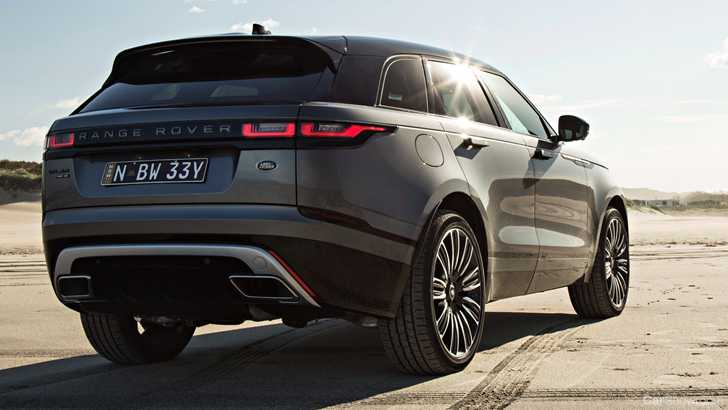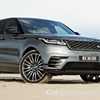Colour our team besotted.
Once you clap eyes on the Range Rover Velar, there’s just no escaping it. With its minimalist design, contemporary flourishes, and distinctly modern flavour, we reckon that if the Range Rover were born in the modern day, this would likely have been its first form.
Only those with a serious gripe against Jaguar-Land Rover would take issue with the design of the Range Rover Velar. Even the profoundly blind would be able to feel the aesthetic majesty of the Velar, but they won’t be able to enjoy the cabin to its fullest. The Velar is not only a contemporary Range Rover on the outside, but the technology jam-packed into the cabin means that even the techiest issue of the iPod-generation will be catered for.
However, with some 41 combinations of trim and drivetrain, you’ll still be left with a headache even after you’ve decided on a Velar over accomplished rivals like the Porsche Macan, Mercedes-Benz GLC, and BMW X4. Thankfully, our testing has revealed some clear sweet spots in the extensive Range Rover Velar… uh, range, and some choice options for the truest connoisseur.
But is the stylish Velar all looks but no trousers? Or is Range Rover’s new niche-filler more than just heart-achingly beautiful?
Exterior
“An elegant exterior design makes a strong first impression for the Velar. Its sophisticated lines help the Velar to sashay perfectly into the existing Range Rover line up, slotting between the Range Rover Sport and the more affordable Evoque.” — CarSales
The Range Rover Velar is not just pretty for a Range Rover. The Velar will undoubtedly go down in history as one of the most beautiful cars of the decade, a category that will also likely feature one of its strongest competitors, the Mercedes-Benz GLC. But where the Merc and the Velar trade blows in terms of design proportions and aesthetic grace, the Velar will definitely take the cake for being that much smarter.
Take the doorhandles, for instance. When the car is locked or on the move, they sit flush within the bodywork, and protrude only at the most opportune moments. Tested to withstand the harshest winters, the doorhandles are guaranteed to work no matter what the condition, even if they’re frozen over with ice.
Then there are the wraparound taillights, which not only present themselves with a 3D effect, but are amazingly efficient in their use of space. The front lights are much the same too, with the LED light signature now sharper and more angular, as befitting what can only be described as a modern Range Rover.
And while sometimes we feel that optional design packs, particularly ones that pretend to be sporty, can ruin carefully-crafted lines, going for an R-Dynamic Velar will bag you a version that isn’t just aggressive, but is passive-aggressive. Think less Hulk Hogan, and more Daniel Craig as James Bond and you’re about there.
Our only advice is to avoid the smaller, less imaginatively-designed alloys. They just look a bit boring and do the Velar a disservice.
Engine & Drivetrain
“The Velar showcases JLR’s full range of 2.0-litre all-alloy ‘Ingenium’ petrol and diesel four-cylinder engines, using a range of technologies and materials to reduce friction and minimise vibration, as well as a 3.0-litre twin-turbo V6 diesel, and 3.0-litre supercharged V6 petrol.” — CarsGuide
The Velar is available with an extensive range of engines, starting first with a P250 2.0-litre turbo-petrol model, that puts out 184kW and consumes a rated 7.6L/100km. A half-step above that is the D180 diesel, which refers to a 132kW oiler that consumes a far more miserly 5.4L/100km.
More power can be had in the P300, which sees the same 2.0-litre turbo petrol pushed to a more considerable 221kW output, with fuel consumption only slightly higher at 7.8L/100km (0.2L/100km difference, a small outlay for more power). If you want more twist, the D240 diesel is the pick of the range (for us, at least) with its 177kW power output and economical 5.4L/100km rated fuel consumption.
The range-topping diesel comes in the form of the D300, which is rated for an impressive 221kW of power from the turbocharged 6-cylinder mill. This engine is remarkably smooth, and works well with the standard-fit 8-speed automatic gearbox (standard across the range mind, not just for the D300). And despite its rapid pace, it consumes just 6.4L/100km on the combined cycle, so we’d definitely recommend this engine for those who absolutely need a six-cylinder mill, especially for those who cover long miles.
The top-of-the-range engine is the P380 though, which takes a 3.0-litre supercharged V6 petrol engine and massages it to put out an astounding 280kW and 450Nm. This is definitely the most characterful engine in the range, with a sonorous V6 howl and creamy-smooth power delivery. However, this engine tempts you most out of all the available options to drive harder, which means that the 9.4L/100km rated fuel consumption will be far from achievable.
Interior
“Concept-car in look and almost hand-crafted in cabin feel, the vaunted Velar raises the game for a Range Rover model in terms of luxury and personalisation.” — Wheels Magazine
The Range Rover Velar sets new standards for cabin quality, in both aesthetics and tactility. The design of the Velar’s cabin is nothing short of breathtaking, even in the base models, thanks in no small part to the new infotainment system that replaces all but the most critical buttons on the centre stack with no less than two touchscreens, with main functionality on the top and secondary functionality (like HVAC controls, TerrainResponse, and other things) relegated to the bottom screen.
Interestingly, the bottom screen is also slightly curved, and it makes way for two rotary dials that either function for the climate control or can also work to adjust settings for whatever sub-menu you happen to be in. Swish stuff.
What’s also notable are the controls on the steering wheel, which are not only touch-sensitive but they change in appearance based on what settings you’re trying to access. So for example, they could be used to adjust the following distance on the adaptive cruise control, or they could display controls for the infotainment system, or they could have a directional-pad type display for you to adjust the settings on the digital instrument cluster.
All cars get the 8-speed automatic gearbox as standard, and so they also get the obligatory rotary gear selector, too.
Behind The Wheel
“It’s no featherweight, but by modern luxury SUV standards the Velar is respectably light. Combined with the low-slung stance it makes for a well behaved wagon.” — Practical Motoring
From the drivers’ seat, the Range Rover Velar is a little divisive. For 90% of buyers that are looking for a comfortable, capable, and confidence-inspiring SUV, the Velar is just that. With the optional air suspension, the Velar is amazingly comfortable, though even the standard setup is hardly uncomfortable. The steering is light and accurate, and allows you to place it very confidently on the road, and as a bonus you’ll find that most traffic will get out of your way thanks its imposing presence.
Wind noise is kept to a minimum, thanks in no small part to the aerodynamics of the thing, as well as the heaps of sound deadening material that’s been shoved into every available inch of the Velar. Road noise too is kept to a minimal level, though larger wheels will attract a slightly noisier ride.
For the other 10% of buyers who are hoping that the Velar will be be a manic car to steer on a B-road, they’ll be left slightly unfulfilled. While the steering wheel is accurate, and weights up rather nicely in Sport mode, it just isn’t as engaging to drive as a comparative BMW X4 or Alfa-Romeo Stelvio. Furthermore, with Sport mode selected, the ride becomes jarringly stiff and rather unbecoming for a Range Rover, without any obvious benefits. It’s clear that the Velar was made for high-speed touring, which it does very very well indeed. Just don’t think this is a B-road barnstormer.
Safety & Technology
“The Range Rover Velar was rated in 2017 with a full 5-star rating, with 93% adult occupant protection, 85% child occupant protection, 74% pedestrian protection, and 72% safety assistance score.” — EuroNCAP
As befitting a large luxury SUV, the Velar isn’t short of safety kit. All cars get autonomous emergency braking that can also detect pedestrians, traction & stability control, brake vectoring, rear cross-traffic alert, tyre pressure monitoring, lane departure warning, roll mitigation system, and driver drowsiness monitoring. You’ll find additional features like blind-spot monitoring, 360º parking cameras, and rear traffic monitor on higher-end models.
All cars get 6 airbags, as well as two ISOFIX anchors in the back for the outer seats.
Technology is well catered for here as well. You’ll find two 10-inch touchscreens in the centre stack, as well as a digital instrument cluster ahead of the driver (reserved for higher-end models, naturally). You’ll also find niceties like TerrainResponse which sets the car up best for various off-road surfaces like mud & ruts, rocks, and sand, though it’s unlikely that most owners will ever take it out of the default ‘Auto.’ But it’s nice that it’s there.
Verdict
The Range Rover Velar might be new to this style-driven niche in the SUV market, but it’s compensated by being ever-so-beautiful to look at inside and out, as well as being a pretty decent steer on the motorway. The Velar might have contemporary looks and up-to-the-minute technology, but it’s likeable presentation appeals in an old-school kind of way, with a comfortable ride and good behaviour at high-speeds on the motorway.
The Velar range might be confusing to look at at first, with some 40-odd different combinations of engines and trims, but the one we’d go for is a mid-range SE with the D240 4-pot diesel. You may think we’re mad for recommending a 4-pot over a V6, but the D240 is surprisingly refined and amazingly frugal, and because it’s small, it keeps the front end of the Velar light and keen on turn-in, something you’ll appreciate in the long-run.
You’ll also like its breadth of ability, given that it remains pretty economical even at town speeds or in traffic.
If you’re keen on an SUV this size that drives better, we’d have to recommend you take a look at the Porsche Macan or Jaguar F-Pace. But if you’re looking for an SUV with an emphasis on luxury and style, the Range Rover Velar is either at the top of your list, or sparring it out with the Mercedes-Benz GLC. And between those two… it’s a coin-toss, really.
Motoring — 79/100 — “The all-new Range Rover Velar boasts both good looks and a treasure trove of technology. Full of details which will appeal to buyers looking for a vehicle a cut above the melee of premium SUVs, the Velar stakes a claim as a genuine competitor for the BMW X3, Audi Q5 and Mercedes-Benz GLC.”
Practical Motoring — 4.0/5.0 — “You’ll have to open up your wallet to truly experience everything the Velar has to offer. It sits neatly between the smaller Evoque and full-size Range Rover Sport… It’s good to drive on-road and better than anything else you’d compare it to away from the bitumen.”
CarsGuide — 8.1/10 — “Land Rover must have a giant reservoir of coolness just sitting in a tank at its Solihull HQ, ready for the Range Rover design team to pump into its new concepts. Because ever since the ground-breaking Evoque launched close to a decade ago, each new Range Rover arrival has sent the brand’s cool factor even further towards sub-zero.”
CarAdvice — 8.5/10 — “The Range Rover Velar is the fourth model in the 'Rangey' family, and it's likely to become the most popular. Like the Evoque, it's a game-changer - and a hint of what's to come.”
Wheels Magazine — 8.0/10 — “Concept-car in look and almost hand-crafted in cabin feel, the vaunted Velar raises the game for a Range Rover model in terms of luxury and personalisation. It’s a very pleasant drive, too, proving easy to place, keen to hug corners, and reasonably comfortable to ride in if the air suspension’s set-up screen reads ‘Comfort’. It’s not as sporty as an F-Pace but the Velar blows its relative away in all the areas that will impact most in Double Bay and Toorak.”
Drive — 7.5/10 — “Beneath the svelte chopped-roof styling, the Velar shares its basic mechanical parts with the Jaguar F-Pace, but, unlike its Jaguar cousin, the Velar doesn’t compromise on Land Rover’s iconic off-roadability while at the same time delivering a new on-road benchmark for the British SUV specialist.”




































